The pandemic ushered in millions of peoples’ first digital health experiences, many of which will persist according to the 23rd Annual U.S. Consumer Technology Ownership & Market Potential Study, published by the Consumer Technology Association.
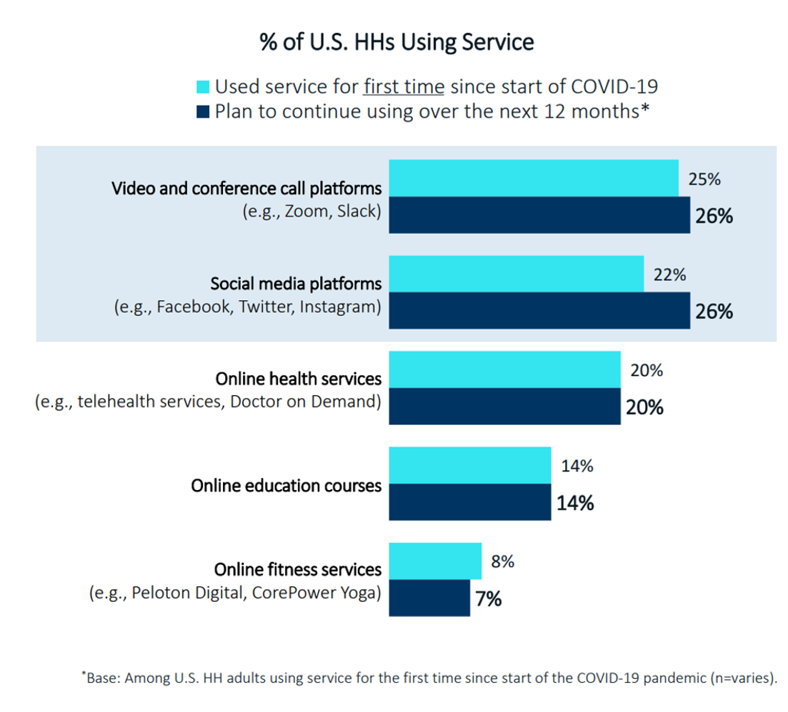 CTA conducted an online survey among 2,409 U.S. adult 18 and over in April 2021 to gather data for this annual report. To ensure a fair sample, CTA drew three datasets for the general population along with an Hispanic oversample and an oversample for people 65 years of age and older.
CTA conducted an online survey among 2,409 U.S. adult 18 and over in April 2021 to gather data for this annual report. To ensure a fair sample, CTA drew three datasets for the general population along with an Hispanic oversample and an oversample for people 65 years of age and older.
The study looked at 83 consumer technology products and sub-categories, including many directly related to medical, health and fitness applications as well as platform technologies that enable digital health activities (such as connected TVs, voice assistants, and smartphones, desktop computers and tablets people regularly use for health care transactions).
CTA tracked consumers’ use of technology throughout the pandemic, and the first chart illustrates important findings that illustrate the digital transformation of people through COVID-19. One-fourth of people used video and conference call platforms in the pandemic for the first time, and one-quarter intends to continue using Zoom et. al. in the next 12 months.
20% of people used online health services, and 20% intent to keep using them.
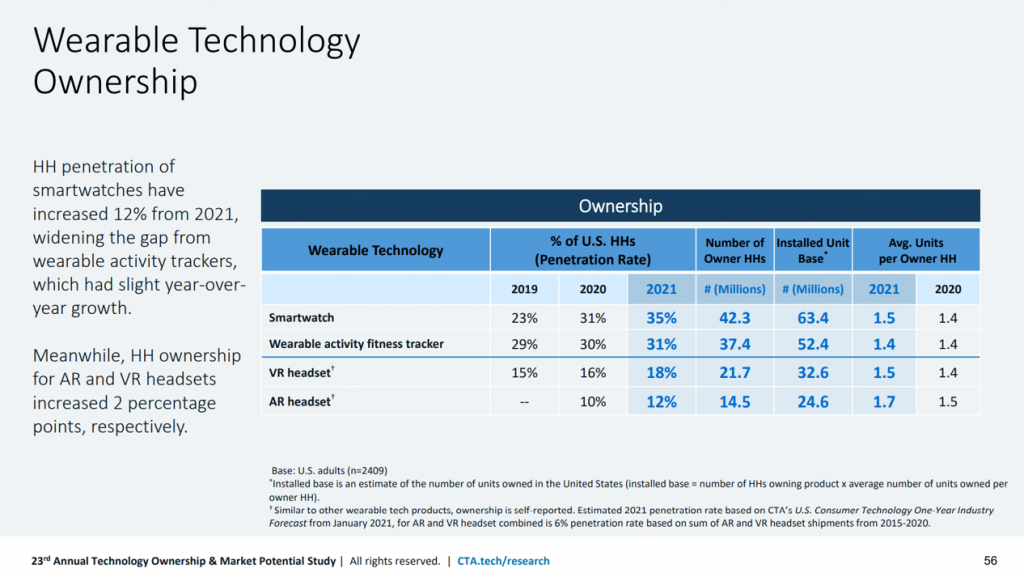 In 2021, smartwatch adoption exceeded wearable activity fitness tracker market penetration, both around one-third of U.S. consumers. Household penetration of smartwatch ownership grew 12%, whereas activity tracker growth was fairly flat between 2020 and 2021.
In 2021, smartwatch adoption exceeded wearable activity fitness tracker market penetration, both around one-third of U.S. consumers. Household penetration of smartwatch ownership grew 12%, whereas activity tracker growth was fairly flat between 2020 and 2021.
Smartwatches also have the 8th highest purchase intent among U.S. consumers (below smartphones, portable charters, home video games and other tech’s), with 63% of those people intending to buy a smartwatch repeat purchasers.
Purchase intent for two other forms of wearable tech, VR and AR headsets, will be 14% and 12%, respectively, among households in 2021, half of whom will be repeat purchasers.
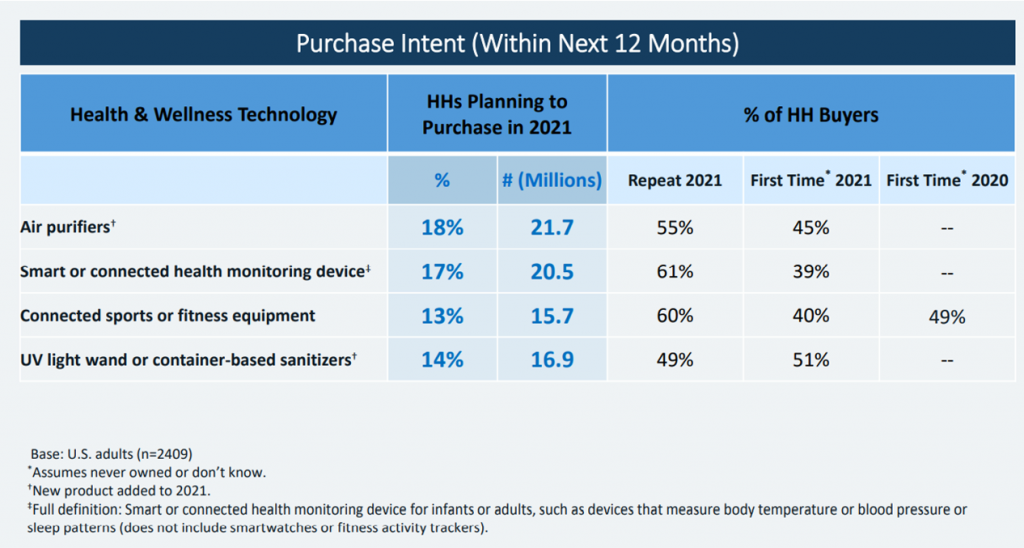 In another lens on consumer health tech, CTA examined consumers health & wellness product ownership for air purifiers, smart/connected health monitoring devices, connected sports and fitness equipment, and UV light wand or container-based sanitizers.
In another lens on consumer health tech, CTA examined consumers health & wellness product ownership for air purifiers, smart/connected health monitoring devices, connected sports and fitness equipment, and UV light wand or container-based sanitizers.
While connected fitness was gauged in 2019, the other three categories were new to the 2021 study.
In 2020, one-fourth of U.S. households owned an air purifier or a smart/connected health monitoring device. One in five households had a connected fitness product, and 16% a digital sanitizer.
Millions of U.S. consumers plan to buy one or more of these devices in terms of purchase intent, ranging from a high of 18% looking to acquire an air purifier in 2021 down to 13% intending to buy connected fitness equipment like a Peloton cycle.
CTA also looked at smart phone ownership which covers many devices; the one most relevant to health applications is the smart speaker, which has 41% of household penetration in 2021. About one in four U.S. households intends to buy a smart speaker in 2021, three-fourths of whom would be repeat purchasers.
CTA concludes the report with some final thoughts: “As consumers look forward to non-screen, out-of-the-home activities, some of the trends that surfaced during the pandemic — including entertainment, health, contactless delivery services and video conference platforms — may continue to stick. But if there is one lesson to be learned from the prior year, it is that technology has further engrained its place in our world, impacting and influencing the way we work, learn, communicate, and entertain.”
Health Populi’s Hot Points: HIPAA, the Health Insurance Portability and Accountability Act, was signed into law in 1996 by President Bill Clinton.
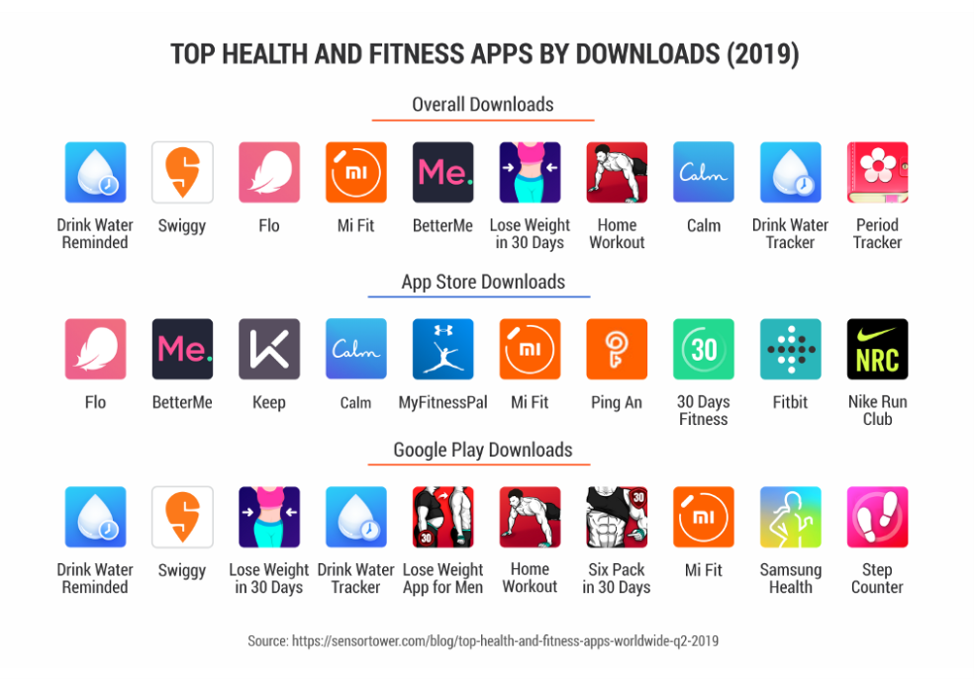 Eleven years later, Steve Jobs launched the first iPhone.
Eleven years later, Steve Jobs launched the first iPhone.
This week, Ken Mandl and Eric Perakslis co-wrote an essay in The New England Journal of Medicine on HIPAA and the “leak of ‘deidentified’ EHR data.”
These digital health experts describe the growth of the use of electronic health records among clinicians in the larger context of the “explosion of data production” since the HITECH Act and growing supply of and market for consumer-generated data.
“It is ironic,” they write, “that although patients (and their physicians) still have difficulty obtaining complete medical record information in a timely fashion, the HIPAA Privacy Rule permits massive troves of patients digital health data to traverse the medical-industrial complex unmonitored and unregulated.”
This begs the question, especially potent in the post-pandemic era, of whether HIPAA is a sufficient mechanism to protect personal health information as it was defined by the law which this year celebrates its 25th birthday.
They offer several potential policy, regulatory and/or legal prescriptions to address the health data tsunami and “leakage” challenge to third parties who often use consumers’ data for purposes beyond medical, health, or wellness objectives. These methods could include:
- Making reidentification of “deidentified” health data illegal
- Considering adopting a GDPR-like regulation with a health citizen’s “right to erasure” (aka the so-called right to be forgotten)
- Ensuring that health care providers adopt best practices for data protection, bolstering patient consent and their digital literacy
- Adopting “behind the glass” access for outside parties to prevent data from leaving institutions, on a project-by-project basis under data-use agreements and contracts that protect consumers’ information.
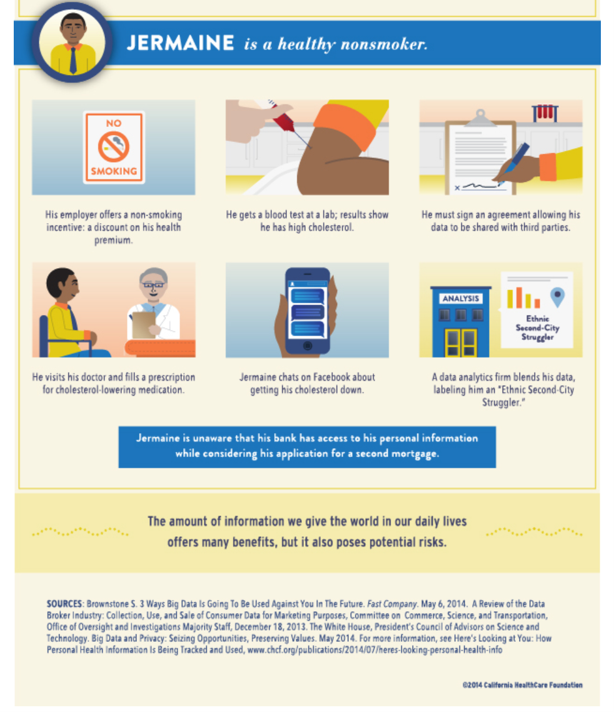 Increasingly, “Big Tech” is morphing into “Big Health,” in the words of Emily Safian-Demers who wrote an essay in Wunderman Thompson Intelligence in May 2021.
Increasingly, “Big Tech” is morphing into “Big Health,” in the words of Emily Safian-Demers who wrote an essay in Wunderman Thompson Intelligence in May 2021.
“Google is ramping up its suite of health tools….[and] turning smartphones into sophisticated health measurement tools….[as well as] exploring a personal health record tool for patients.”
Emily also talks about Amazon planning a new health diagnostics are for at-home medical tests, and Microsoft investing heavily to build out its health care footprint.
“In an era where every business is now a health business,” Emily concludes, “Big Tech is upping the ante.”
Consumers want more virtual care, health care at home, and more control over their lives in the post-pandemic era. CTA’s data demonstrate people are already keen to spend household budgets on tech and devices that help them make health at home.
The importance of real-world evidence, generated by patients where we live, work, play, and learn, cannot be underestimated for clinical research, real-time diagnosis, and personalizing medicine to bolster health outcomes. At the same time, that information is at once highly valuable and higher personal. Mandl and Perakslis are right to argue that, “health systems, legislators, and regulators now have an opportunity to protect health record data to a greater degree than the law mandates.”
In my 2014 paper for California Health Care Foundation, Here’s Looking at You: How Personal Health Information Is Being Tracked and Used: ” I quoted James Pyles, Esq., of Powers Pyles Sutter & Verville PC, who said something seven years ago that resonates even stronger today:
“Electronic health information is like nuclear energy. If it’s harnessed and kept under tight control, it has potential for good. But if it gets out of control, the damage is incalculable.”
The post The Pandemic Accelerated Consumers’ Digital Health Tech Ownership As Big Tech Morphs To Big Health appeared first on HealthPopuli.com.
The Pandemic Accelerated Consumers’ Digital Health Tech Ownership As Big Tech Morphs To Big Health posted first on https://carilloncitydental.blogspot.com
No comments:
Post a Comment